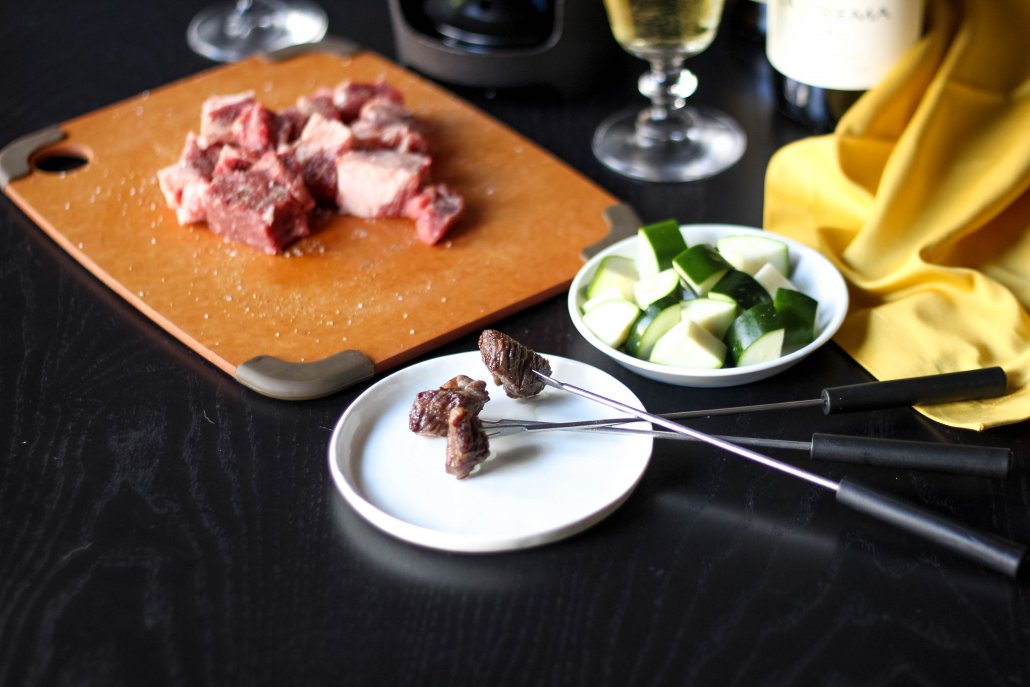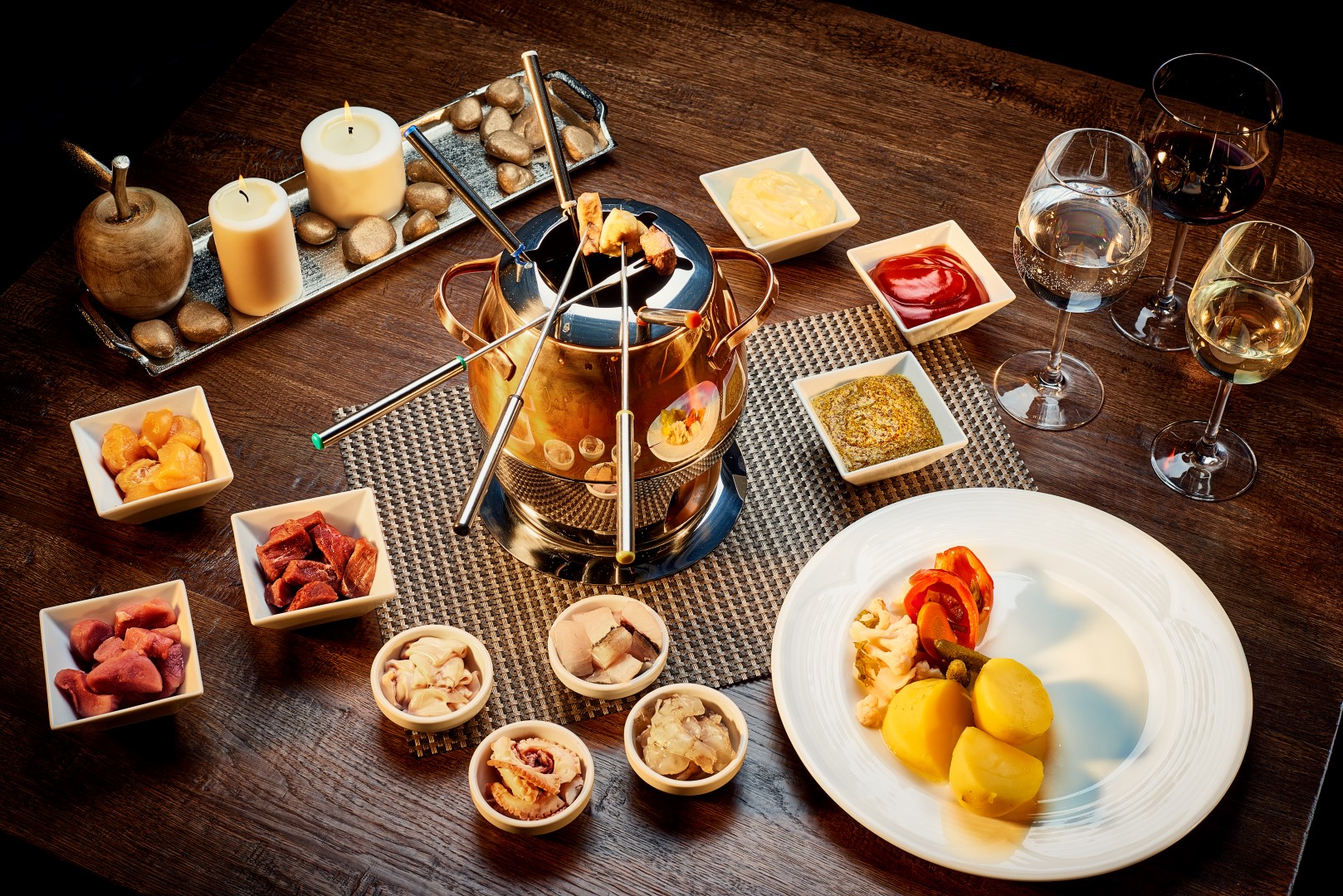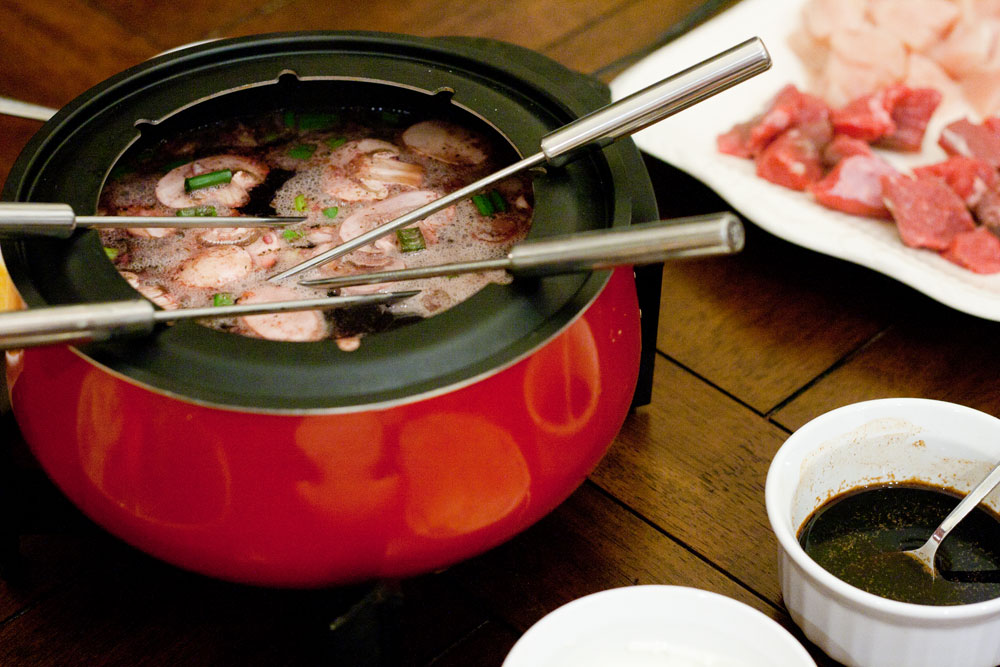What is really fondue?
Fondue is a traditional Swiss dish that is prepared from different types of Swiss cheeses. It has been declared a national dish of Switzerland and has already established itself as one of the main symbols of Alpine cuisine.
For the preparation of fondue, cheeses such as Emmental, Gruyere, Appenzeller, Vacherin, Raclette can be used. There is no single type of cheese that is preferable to the rest for the preparation of fondue.
The cheeses are cut or grated and placed in one portable metal container called caquelon which is heated on an alcohol burner or a candle. The container is wide and shallow which helps to maintain the temperature of the mixture for longer.
White wine, corn flour, salt and pepper are added to the cheese. You can also add some Swiss brandy called Kirsch (a type of cherry brandy whose name Kirchwasser means “cherry water”). Thus, while melting, the cheese is continuously stirred until a homogeneous mixture without lumps is obtained.
The mixture for fondue must be of precise consistency, neither very dense nor very rare, and the same temperature must be maintained. It is consumed by sticking bread, meat, fish and different vegetables such as pickles, broccoli, carrots and potatoes cubes on long metal forks. Before putting the products in the caquelon, you can first rub it with a clove of garlic for more flavor.
Fondue has 4 varieties: with cheese, with fat, with vegetable broth and with original Swiss chocolate.
How is fondue with fat prepared and how is it consumed?
Fondue with fat is made on the same principle as other types of fondue but instead of cheese, fat is put in to the caquelon. While chocolate fondue can be prepared in a ceramic container, for the fondue with oil a copper, stainless caquelon must be used which has handles and special finger-stalls on the upper edge to protect us from burning with the boiling liquid.
Various bites such as cubes of meat, bread, canned vegetables like gherkins, for example, are dipped in the hot fat and cooked. The fat is heated to 180-190 degrees. The oil can be different types: sunflower, rapeseed, peanut, grape seed oil, purified oil. The meat can be chicken, veal, pork, veal fillet or loin, veal tenderloin as well as various fish and seafood such as perch, salmon, octopus, lobster, shrimp, and mussels.
Bites of meat, bread or vegetables should be dry as water causes frizzing. They are dipped again with the help of forks with long handles, and after they are ready, they are placed in a separate dish to get cold well, and then they are eaten with standard forks.
They are salted once they are prepared in the fat and not before. Having too many forks in the liquid can lead to cooling. This fondue can be served with a garnish of stewed broccoli, cauliflower, carrots, pickles, small pickled onions, asparagus, and butter sauce with lemon, garlic and dill oil and with sauces such as ketchup, mustard and mayonnaise.
Drinks that can accompany the fondue are white wine, cherry brandy and herbal tea; drinking water, juice or beer should be avoided as this obstructs digestion. Fondue is usually considered a main dish but can also be consumed as an appetizer or a snack.
For example, a recipe called moitiè-moitiè, which includes two equal parts of Gruyere and Vacherin, is popular. However, for example, in the eastern part of Switzerland, it is accepted for Gruyere to be mixed with Vacherin.
How is fondue consumed?
Fondue eating has certain rules. It is considered as bad manners, for example, if one puts their fork down for too long and the piece of bread falls apart.
Fondue is consumed slowly and carefully. Once we dip and take out our bite, we leave it to strain off the fat well and then take it out of the container. The Swiss jokingly say that whoever drops their bite in the caquelon either has to kiss the person next to them or pay the whole bill.
We do not eat with the fondue fork because it’s pretty sharp and impractical. We use it to dip the bite into the liquid, then leave the bite in our plate and eat it with a short knife and a fork. If we have a cheese fondue, for example, after the cheese mixture in the container is over, a crust called religieuse is formed. It is scraped and served at the end of the meal as a delicacy.
When was the fondue invented?
The name fondue comes from the French word “fondre” meaning “to melt”. This so popular and typical for the winter season dish continues to increase its reputation throughout the world to such an extent that its name has already become a cliche. Not all of us, however, suspect how old its roots are. The earliest cooking recipe for fondue dates back to the 18th century. It appeared in 1699 published in a cookbook in Zurich called Let’s cook cheese with wine.
Originally fondue was prepared only with cheese and wine and then other versions of the recipe began to be created. Fondue was invented by shepherds living high in the mountain in the Swiss canton of Valais which is famous for its beautiful mountain views and climate predisposing for the cultivation of fine wine and a variety of cheeses.
Swiss farmers were looking for a simple meal from affordable products such as cheese and vegetables, as food supplies were limited in the winter months. They wanted a dish that was warm and cozy after a long winter day. So they decided to use the old bread by consuming it with melted remains of cheese and a little wine by the family hearth.
Since bread was not been baked every day, often the available bread was old. However, after dipping it into the cheese, the bread softens and becomes delicious. The fondue recipe was quickly discovered also by wealthier people who appreciate the extraordinary simplicity of this simple but tasty dish.
Disputes arise as to where the idea of fondue with fat originates from. Also called the Burgundy fondue, it is believed that fondue with fat comes from the region of Burgundy in France.
The workers who worked in the vineyards there and the owners of the vineyards wondered how many people could receive hot food at once. So the owners came up with the idea of putting large containers with grape seed oil near the vineyard fields, allowing grape harvesters to feed when they wanted to.
Workers carried with them pieces of meat from home. They stuck the pieces of meat onto sticks and dipped them in the hot oil until they cooked. So after eating, they could quickly return to the field and harvest the grapes in time when they were the most mature.
An interesting fact is that since 1905, the addition of corn starch to the fondue mixture begins, which results in a smoother, denser and more homogeneous mixture of cheeses to prevent it from separating. The classic recipe for fondue also has variations such as the addition of eggs, cream, butter, truffles and various spices such as nutmeg, paprika and chili powder. Fondue reached America only in 1964 when it was presented by an Alpine restaurant at a culinary fair.
In addition to offering us a great way to warm up during the cold winter days or to recharge with energy after skiing, this traditional Swiss dish is itself a social event. Fondue is a dish that gathers all family members or friends at the table and makes them share the same food, as everyone eats from the common caquelon and spends time together.


![[:bg]Фондю с месо снимка[:en]Fondue with meat photo[:]](https://fondue.bg/wp-content/uploads/2018/03/fondue-and-oil-cover.png)


